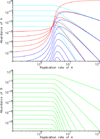From prelife to life: how chemical kinetics become evolutionary dynamics
- PMID: 22335792
- PMCID: PMC4610729
- DOI: 10.1021/ar2002683
From prelife to life: how chemical kinetics become evolutionary dynamics
Abstract
Life is that which evolves. Living systems are the products of evolutionary processes and can undergo further evolution. A crucial question for the origin of life is the following: when do chemical kinetics become evolutionary dynamics? In this Account, we review properties of "prelife" and discuss the transition from prelife to life. We describe prelife as a chemical system where activated monomers can copolymerize into macromolecules such as RNA. These macromolecules carry information, and their physical and chemical properties depend to a certain extent on their particular sequence of monomers. We consider prelife as a logical precursor of life, where macromolecules are formed by copolymerization, but they cannot replicate. Prelife can undergo "prevolutionary dynamics", including processes such as mutation, selection, and cooperation. Prelife selection, however, is blunt: small differences in rate constants lead to small differences in abundance. Life emerges with the ability of replication. In the resulting evolutionary dynamics, selection is sharp: small differences in rate constants can lead to large differences in abundance. We also study the competition of different "prelives" and find that there can be selection for those systems that ultimately give rise to replication. The transition from prelife to life can occur over an extended period of time. Instead of a single moment that marks the origin of life, prelife may have seeded many attempts for the origin of life. Eventually life takes over and destroys prelife.
Figures



Similar articles
-
Chemical roots of biological evolution: the origins of life as a process of development of autonomous functional systems.Open Biol. 2017 Apr;7(4):170050. doi: 10.1098/rsob.170050. Open Biol. 2017. PMID: 28446711 Free PMC article. Review.
-
Prevolutionary dynamics and the origin of evolution.Proc Natl Acad Sci U S A. 2008 Sep 30;105(39):14924-7. doi: 10.1073/pnas.0806714105. Epub 2008 Sep 12. Proc Natl Acad Sci U S A. 2008. PMID: 18791073 Free PMC article.
-
Originator dynamics.J Theor Biol. 2009 Feb 21;256(4):586-95. doi: 10.1016/j.jtbi.2008.10.006. Epub 2008 Oct 21. J Theor Biol. 2009. PMID: 18996397 Free PMC article.
-
Prelife catalysts and replicators.Proc Biol Sci. 2009 Nov 7;276(1674):3783-90. doi: 10.1098/rspb.2009.1136. Epub 2009 Aug 19. Proc Biol Sci. 2009. PMID: 19692408 Free PMC article.
-
On the emergence of biological complexity: life as a kinetic state of matter.Orig Life Evol Biosph. 2005 Apr;35(2):151-66. doi: 10.1007/s11084-005-5272-1. Orig Life Evol Biosph. 2005. PMID: 16010995 Review.
Cited by
-
A necessary condition for coexistence of autocatalytic replicators in a prebiotic environment.Life (Basel). 2013 Jul 24;3(3):403-20. doi: 10.3390/life3030403. Life (Basel). 2013. PMID: 25369813 Free PMC article.
-
Chemical roots of biological evolution: the origins of life as a process of development of autonomous functional systems.Open Biol. 2017 Apr;7(4):170050. doi: 10.1098/rsob.170050. Open Biol. 2017. PMID: 28446711 Free PMC article. Review.
-
Foldamer hypothesis for the growth and sequence differentiation of prebiotic polymers.Proc Natl Acad Sci U S A. 2017 Sep 5;114(36):E7460-E7468. doi: 10.1073/pnas.1620179114. Epub 2017 Aug 22. Proc Natl Acad Sci U S A. 2017. PMID: 28831002 Free PMC article.
-
The origin and early evolution of life in chemical composition space.J Theor Biol. 2018 Nov 7;456:295-304. doi: 10.1016/j.jtbi.2018.08.016. Epub 2018 Aug 12. J Theor Biol. 2018. PMID: 30110611 Free PMC article.
-
Non-associative phase separation in an evaporating droplet as a model for prebiotic compartmentalization.Nat Commun. 2021 May 27;12(1):3194. doi: 10.1038/s41467-021-23410-7. Nat Commun. 2021. PMID: 34045455 Free PMC article.
References
-
- Rasmussen S, Bedau MA, Chen L, Deamer D, Krakauer DC, Packard NH, Stadler PF, editors. Protocells: Bridging Nonliving and Living Matter. MIT Press; 2008. - PubMed
-
- Deamer D, Szostak JW, editors. The Origins of Life. Cold Spring Harbor Laboratory Press; 2010.
-
- Fontana W, Schuster P. Continuity in evolution: on the nature of transitions. Science. 1998;280:1451–1455. - PubMed
-
- Eigen M. Selforganization of matter and the evolution of biological macromolecules. Naturwissenschaften. 1971;58:465–523. - PubMed
Publication types
MeSH terms
Substances
Grants and funding
LinkOut - more resources
Full Text Sources
Other Literature Sources

